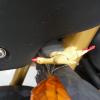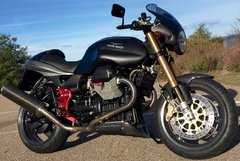Leaderboard
Popular Content
Showing content with the highest reputation on 05/21/2020 in all areas
-
After reading docc's original post on this I liked the idea he had and the way he did it so I went out and looked at the 30 fuse receptacle on my Greenie , even though it was still functioning it was indeed burnt and starting to disintegrate ..so looking to head off a future issue I followed docc's link for the aircraft breaker mod and ordered one up, and then try to copy his install ....fun little project and satisfying as well!!4 points
-
Just installed a new set of these on my 03 Le Mans. I put them on my Scura about 8 years ago and they really make a difference. They are now discontinued, but I emailed Customer Service and they located the old V11 template and were happy to make a pair. If interested, call Customer Service at 775-783-5110. The model # is on the second photo.3 points
-
Just enjoying life, 16c today. D IPA time. Cheers Tom. Sent fra min SM-A505FN via Tapatalk3 points
-
V11 has a shorter wheelbase and skinnier tyres and will steer quicker. Also as delivered the Griso's forks are under sprung and over damped and they are run far too low in the yokes. You can't see very well in the pic of mine but the forks, which are Sachs off an RSV4 with Matris internals are lifted to six rings through the yokes, that makes a big difference and next time the Matris shock is rebuilt it will get spaced to lift the rear by an inch which improves things even further. The original Sachs shock is once again under sprung and over damped and the valving and damper screws needles are very coarse. Chances are any Griso you have ridden was poorly mapped and quite possibly incorrectly tuned. I remain gobsmacked how even now, fourteen years after the system started being used, the number of W5AM bikes I see that have been seriously messed up because the people who are working on them don't have a clue, not just owners but *Mechanics* as well! There has never been an easier system to tune but still people screw it up and in a lot of cases once screwed it is very difficult to unscrew it! If the early, 1100, Griso had a major failing it was the de-tuning by fitting smaller throttlebodies than the V11 and, oddly, the greater attention to balancing components. The 1100 is in such a high state of refinement that in stock trim it has lost some of the visceral anger of the V11 donk. That was well and truly addressed with the 1200 but it was let down by at first dreadful and eventually better but still uninspiring mapping and of course it was all for nought due to the dreaded flat tappet fiasco! Once rollerised and mapped correctly the 1200 is an awesome powerplant! A true 'Turbo-Tractor' with torque from nothing to rev limiter and a genuine 100 hp at the rear wheel readily available, (Although getting much more out of the motor is difficult due to its cylinder head design and combustion chamber and the cam timing. Best I've seen on they Dyno on mine was 104. Last time, (Years ago!) I dyno'ed it with its current map I got 102. Every stock 8V I've ever put on a dyno has made 96 on the nail. I'm sure that with some cam and head work you could get a few more hp if you're into bragging rights but in doing so you'd sacrifice the linear torque curve and pure driveability. I think Phil's weight estimate, at least for the 8V, is probably a bit optimistic but it doesn't weigh that much more than a V11. Anyway, at the end of the day both designs are now obsolete replaced by the insipid feebleness of the V85 powerplant. You pays yer money and you takes yer choice. It's not a matter of better or worse, just different.3 points
-
They look very complimentary on your LM! That smokey gray is a great color. I wonder about black pads on a greenie tank. It could set it off nicely or clutter and take away from the awesome green mass of the tank.2 points
-
That actually has a Moto Guzzi part number: GU973221100021 Cadre Cycle looks to have them: https://cadrecycle.com/product/tank-protector/2 points
-
https://www.motorcyclistonline.com/moto-guzzi-motorcycles-griso-8v-se-short-shift-review/ Here you know they actually weighed it and didn't rely on Italian marketing. 557/531 lb. (tank full/empty) https://www.motorcyclistonline.com/moto-guzzi-v11-sport-road-test/ Weight 546 lb. (wet) 511 lb. (fuel tank empty) So they are saying 20 lbs difference.2 points
-
I just had to highlight that in green for the . . . well, you know who you are . . .2 points
-
That cracks me up - exactly what I thought! I'm with swoosh' , fill-up from empty = 5.1 US gallons. I seem to recall ~0.8 US gallons trapped on the right side of the tank, so "technically" ~5.8 is "correct." Don't make me post my proof photo on the tank testing . . .1 point
-
1 point
-
Possibly because the V11 traps around 3 litres of fuel that's unusable? If you add that to the 5 gallons you put in where you still hadn't actually run out of fuel then it's probably close to the 5.8 Gallons. Ciao1 point
-
1 point
-
I think they'll look great. I've put similar on a dozen bikes of different colors and I'm always pleasantly surprised with how good it looks. But more importantly, it gives you so much more stability on the bike, especially when stopping or hanging off.1 point
-
They have the V11 Sport tank listed at 5.8gal, the most I've ever put in was 5. You sure would think I could go farther with a 5.8gal tank.1 point
-
Yes, you remove the same way as installing, first warm it up good with a hair dryer, or heat gun on low setting. It comes off with no problems. For installation, you warm up the tank and pad ahead of time. Since the tank has some significant contours in that area, per the instructions you start in the middle and work your way to the perimeter. I cut out a 2.5" swath of the backing paper from top to bottom, aligned it and applied, kneeding from the center up and down. Then removed the other two pieces of backing paper one at a time, and again pressed from the middle to the perimeter. Mine came out perfectly with no bubbles.1 point
-
1 point
-
1 point
-
Looks good. I’ve been thinking about putting the clear protective film on my tank, but maybe this is a better way to go, actually get some performance benefit with the protection. Is this safe for the paint finish? Does it come off with no harm done? Btw, where did you get the Moto Guzzi tank guard?1 point
-
So, full of fuel, that's 5 kg. Not far off from the 3kg that was stated. I've long said that at 500 pounds, my Sport is on the side of the road out of gas. . .1 point
-
Yeah, my experience is different as well. The vacuum bleeders work, but the power bleeder works better. The vacuum bleed tends to suck air past the threads on the bleeder fitting. Also, an old trick after bleeding a system with a vacuum bleeder is leaving the bike overnight with the brake lever pulled in to apply pressure to the system. That pressure seems to help trapped air make its way to the top. When you release the brake lever the next day the air comes out into the reservoir and the brakes are firmer. Pressure seems to help get ride of air bubbles.1 point
-
1 point
-
One day I weighed the Monza, AeroLario, and Mighty Scura on some aircraft scales that we use for weight and balance calculations. Naturally, I *forgot* to write them down. I posted them on WG, and now can't find that thread. I *was* surprised at how little more the Lario weighed than the Monza, and how little more the Scura weighed than the Lario, though. *From failing memory,* the Mighty Scura was 495 lbs with an empty fuel tank, though. I thought it would be more.1 point
-
"Real world weights" are not easy to come by or derive. Even diligent efforts have to be qualified with all the various vagueries that enter the equation . . .1 point
-
"under-sprung and over-damped", that was part of Colin Chapman's formula for making Lotus the best handling cars on earth back in the day. Of course, developing super lightweight packages helped quite a bit as well (not part of Guzzi's formula) [emoji16]1 point
-
For the power bleeder, just buy extra caps for the bike. Drill a hole, install a hose.1 point
-
No, it still uses Hookes couplings the same as they always have. The reactive system is not very different to that of the Spineys it's just that rather than the bevelbox floating on the rear wheel spindle with the reaction rod going from box to frame with the CARC set up the crownwheel and pinion are carried in a reactive bridge Which is contained within the bevelbox castings and the crownwheel support bearings perform the function of wheel bearings as well as the wheel is bolted directly to the crownwheel carrier. The bevelbox part of the system is still heavy because, at the end of the day it is still a bloody great gearbox but it is considerably more compact than a Spiney bevelbox. The reason for the seemingly massive swingarm is that the reactive, 'Up and down' movement of the pinion as it reacts to power and suspension inputs has to take place inside the swingarm. The arm itself is very light. The driveshaft is bulkier than that used on the Spineys because it incorporates the large rubber torsion bush which is the only driveline shock absorber in the 8V transmission.1 point
-
The deal on Ben Harper, I'd never heard of the guy. My wife is a retired English teacher and a student gave her a mix CD(20 years ago?) . It's just great. The CD had "Mama's Girl Friend" and "Rodney King". It was all roots/folks. Later I'd seen his rock and blues stuff. I was just talking to my wife today and said that I can categorize his music in two words. She said what is it? I said, "Ben Harper". I need to get his blues and rock stuff. What a great human being and great musician.1 point
-
Guzzi2Go, thank you for your excellent post! I have edited and amended my posts throughout the thread. As you say, no more than 15vDC charging! (Amperage is "unlimited", but should not be below 6 amps to *charge* the PC545). Regarding the "battery priming" (discharging before starting or charging?): >Here is the reference post: http://www.v11lemans.com/forums/index.php?showtopic=18838&p=201259 >The post with the "empirical" observation: http://www.v11lemans.com/forums/index.php?showtopic=18838&p=208912 > This is the *technical bulletin* that I have referenced for some of my conclusions: http://www.cdtechno.com/pdf/ref/41_2128_0212.pdf > EnerSys (Odyssey) technical reference: “reconditioning charge cycle procedure.” Note "Action Procedure: 1. Discharge the battery . . ." http://www.odysseybattery.com/documents/ODYSSEY_Battery_Reconditioning_Charge_Procedure.pdf1 point
-
Sorry to say so, but this does not sound right to me... (if these statements have been retracted in the meantime, I apologize for pointing to them "again") The "charging system" on the V11 consists of nothing more than a voltage regulator (not a current regulator, as stated above). In Guzzi's case, it regulates to 14-14.6V on its own terminals (not battery). The voltage on terminals never exceeds 14.6V, If it does, the regulator is faulty. Charging current is theoretically limited by the regulator's voltage, battery's state of charge (voltage on the battery with no load), battery's internal resistance (milliohms range) and parasitic resistance of the wires and connectors between the charger and the battery (also low ohm range), practically however it is limited by the alternator's/regulator's capacity. Max current that the regulator can deliver is 27,5A@10k RPM (~400W). You will need roughly half of that to supply the regular load (150-200W), so not more than 10-15A will be available to the battery at any time. Only battery can blow the 30A fuse, regulator cannot. If it's blown, there is a short southward of the battery/fuse. Docc, where did you find that info on "battery priming"? Odyssey is quite explicit on "never exceed 15V" and their charger's documentation also does not provide any statements on high current/voltage spikes. Can you perhaps post a link to a document? I know my comment is more than a year late and I sincerely hope it does not spur a flame war. This is definitely not the intention.1 point
-
Chuck, if it's an AGM battery, let it discharge statically without the tender. When it falls to 12.65, discharge with the lights a few minutes and apply 6 amps minimum until it reaches 14.8 or so. Follow with a "float" charge of 13.5-13.8v. Repeat until it keeps a proper SOC (State of Charge) / Open Current Voltage (12.84). If your tender doesn't float at 13.5-13.8, it is ungood for the AGM. Below 13.2v is damaging.1 point
-
After getting the wrong charger twice (and returning it twice) via Amazon, I ordered from Northern Tool. Along with the correct charger came a large and highly distracting tool catalog (I mean an actual paper catalog...). I chose BatteryMinder 12248, because it is supposed to work on AGM, Gel, and Flooded batteries. I have a couple RV batteries for my trailer that have sat far too long - hoping this charger can make them useful again. I have four old motorcycle batteries to experiment with, but will start with the PC545 that came with the wrecked LeMans I bought. Here's the battery's story as best as I can tell: Manufactured August 2011 (0811 on sticker) Sat in bike for an extended period after crash - exact time unknown, but likely over 1 year, and the guy I bought it from had charged it once. After I got it home, I charged it with a simple Battery Tender - then got the wreck started to be sure the engine was still good. After dismantling, the battery sat for several more months on a wood bench (never on concrete) - I think I connected it to battery tender once during that time. Today it produced 12.50 volts - which is about 50% capacity according to the BatteryMinder booklet. With the charger: First connected charger to battery, then selected 2A and AGM, then plugged into A/C power. Note that it seems important to make the correct selections before plugging into A/C - the unit draws power from the battery to enable you to push the buttons to select battery type and charge rate. It started blinking (meaning fully charged) within 5 minutes. I disconnected and measured 12.69 volts. Then reconnected and will let it do its thing for about a week to see if it will restore the battery to 100% capacity. Per the manual: "If voltage is 12.4V or higher, a full recovery can be expected, given sufficient time (average 1-2 weeks for batteries that are heavily sulfated)." Ambient temperature:1 point
-
The discharge warming up and better starting that goes with it is all to common with the Lithium batteries. There it really can make a large difference. I don't think it makes quite as big a difference with lead/acid batteries, but it certainly can make enough of a difference if you are marginal.1 point
-
Regarding chargers, I have a few of the $20 Shumacher charge/maint. type from Walmart. They take the battery all the way up to 14.40V, and then go into float mode. I've have excellent results with these, but I also use a 24hr timer. It's like plugging it in once a day for a couple of hrs. 10+ years on OEM batteries. Pb acid, and AGM. Note that these chargers are rated for at least 1.5A charging. IMHO, much better than a Battery Tender Jr. (0.5A ??) I also own an older Battery Minder. Awesome charger with the desulphation mode that I've SEEN work. It removed some desulphation from a 16AH "wet" cell battery on my Ducati ST2 years back. That OEM battery went close to 8 years. I prematurely replaced it only to "upgrade" to a 22A-hr AGM.1 point














